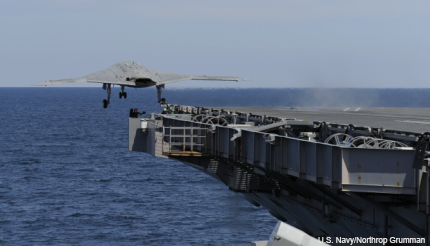Navy advancing carrier-based drone program
NAVAIR issues a draft RFP to the four companies already working on designs for the UCLASS system, which the Navy expects to be operational by 2020.

The X-47B is the Navy's first carrier-based drone; the UCLASS system will be next.
The Navy is moving forward with its plan to build carrier-based unmanned aircraft capable of conducting surveillance and strikes in high-risk areas. The Carrier Launched Airborne Surveillance and Strike (UCLASS) system is in the preliminary design phase, and the Navy expects to issue a final RFP later this year and award a contract in 2015.
The Naval Air Systems Command recently issued a draft request for proposals to the four companies already working on designs for the aircraft—Boeing, Lockheed Martin, General Atomics and Northrop Grumman—looking for input on developing, testing and integrating the air segment of the program. UCLASS is a three-segment program consisting of a control system and connectivity segment, a carrier segment and an air segment, NAVAIR said.
The four companies each received $15 million contracts in August 2013 to work on the preliminary designs, AINonline reported. The Navy, which requested $403 million for the program for fiscal 2015, reportedly plans to have operational UCLASS systems by 2020.
UCLASS is the Navy’s second carrier-based drone program. Under the Unmanned Combat Air System Demonstration program, Northrop Grumman built the X-47B, which has completed several successful launches and landings.
Long-range, carrier-based unmanned aircraft are seen as an important part of the military’s shift to focusing on the Asia-Pacific region, where intelligence, surveillance, reconnaissance (ISR) and other missions will cover a vast area. One requirement for the X-47B, for instance, was that it be able to refuel in the air in order to extend its missions.



